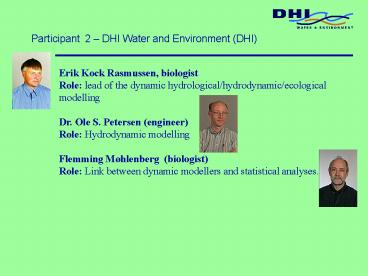Participant 2 DHI Water and Environment DHI - PowerPoint PPT Presentation
1 / 18
Title:
Participant 2 DHI Water and Environment DHI
Description:
Participant 2 DHI Water and Environment (DHI) Erik Kock Rasmussen, biologist. Role: lead of the dynamic hydrological/hydrodynamic/ecological modelling ... – PowerPoint PPT presentation
Number of Views:72
Avg rating:3.0/5.0
Title: Participant 2 DHI Water and Environment DHI
1
Participant 2 DHI Water and Environment (DHI)
Erik Kock Rasmussen, biologist Role lead of the
dynamic hydrological/hydrodynamic/ecological
modelling Dr. Ole S. Petersen (engineer) Role
Hydrodynamic modelling Flemming Møhlenberg
(biologist) Role Link between dynamic modellers
and statistical analyses.
2
MIKE - Model Structure
- Disharge
- Precipitation
- Evaporation
- Water levels
- Fluxes
- Wind
- Temperature
Hydrodynamic modelling
- Initial values
- Boundaries
- Point sources
- Diffuse sources
Advection-Dispersion modelling
Effects on
- Temperatur
- Salinity
Nutrient load
Ecological modelling
Water level, current, salinity Chlorophyll, subm.
Vegetation, nutrients, BOD, Oxygen,
3
Ecological model, carbon cycle
4
MIKE EU
- The simulated 12 components or the state
variables of the model are - Phytoplankton carbon (PC) (g/m3)
- Phytoplankton nitrogen (PN) (g/m3)
- Phytoplankton phosphorus (PP) (g/m3)
- Chlorophyll-a (CH) (g/m3)
- Zooplankton (ZC) (g/m3)
- Detritus carbon (DC) (g/m3)
- Detritus nitrogen (DN) (g/m3)
- Detritus phosphorus (DP) (g/m3)
- Inorganic nitrogen (IN) (g/m3)
- Inorganic phosphorus (IP) (g/m3)
- Dissolved oxygen (DO) (g/m3)
- Benthic vegetation carbon (BC) (g/m2)
- Add on Benthic vegetation split into macroalgae
Rooted vegetation - Add on Sediment N P module.
5
MIKE 21, 3-D Finite Element Model System
- Hydrodynamic module
- (Water level, discharge velocity)
- Advection dispersion module
- (Transport of substances)
- Ecological Module
- (22 state variablesTN, TP, IN, PO4, Chl-a,
Zooplankton, N and P in sediment, Rooted
vegetation, Macroalgae)
6
MIKE 21, 3-D Finite Element Model System
- Hydrodynamic module
- (Water level, discharge velocity)
- Advection dispersion module
- (Transport of substances)
- Ecological Module (ECO-lab )
- (22 state variablesTN, TP, IN, PO4, Chl-a,
Zooplankton, N and P in sediment, Rooted
vegetation, Macroalgae)
7
Development of ECO-lab
ECO-lab released July 2003 for MIKE 21
3D ECO-lab template Eutrophication (EU) model
with 13 state variable Sep. 2003 P.Plankton,
Zoopl. NH4,NO4, PO4, DC,DN,DP, DO ECO-lab
template Mytilys e. population EU model 50
state variables, Oct. 2003 ECO-lab template EU
model with macroalgae rooted submerged
vegetation sediment N, P to be released summer
2004, 22 state variables ECO-lab for FM to be
released May-July 2004
8
Eco-lab applications Ringkøbing Fjord Løgstør
Broad, Danish Straits
9
(No Transcript)
10
Secchi depth Ringkøbing Fjord1992 (6-8 PSU),
2001 (10-14 PSU)
Phytoplankton dominate
Filtration by Mya areneria
11
Secchi dept, PSU from 10-14 to 6-8
Mya a. can not reproduce below 13 PSU, SD decrease
12
Shell fish (Mytilus e.) population model in
ECO-lab based on a 3-D model of Løgstør
BroadBoundary Data MIKE 11 1-2 weekly data on
water chemistry
13
(No Transcript)
14
(No Transcript)
15
Measured Load in rivers channels for the
ecological model Table 3
16
Boundary condition at the Sea for the Ecological
modelTable 4
17
Forcing functions Ecological modelTable 5
18
Calibration validation dataecological
modelTable 6































